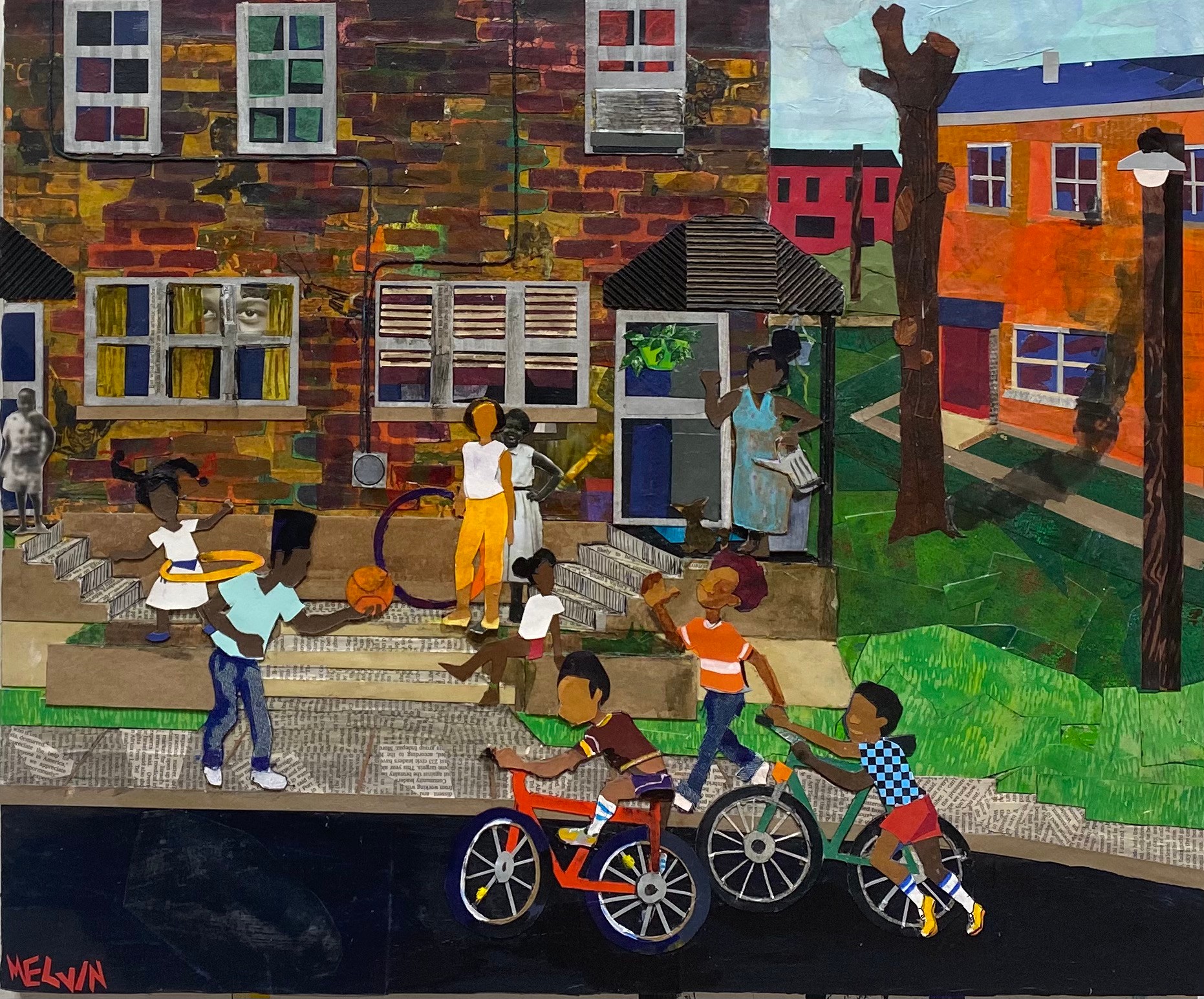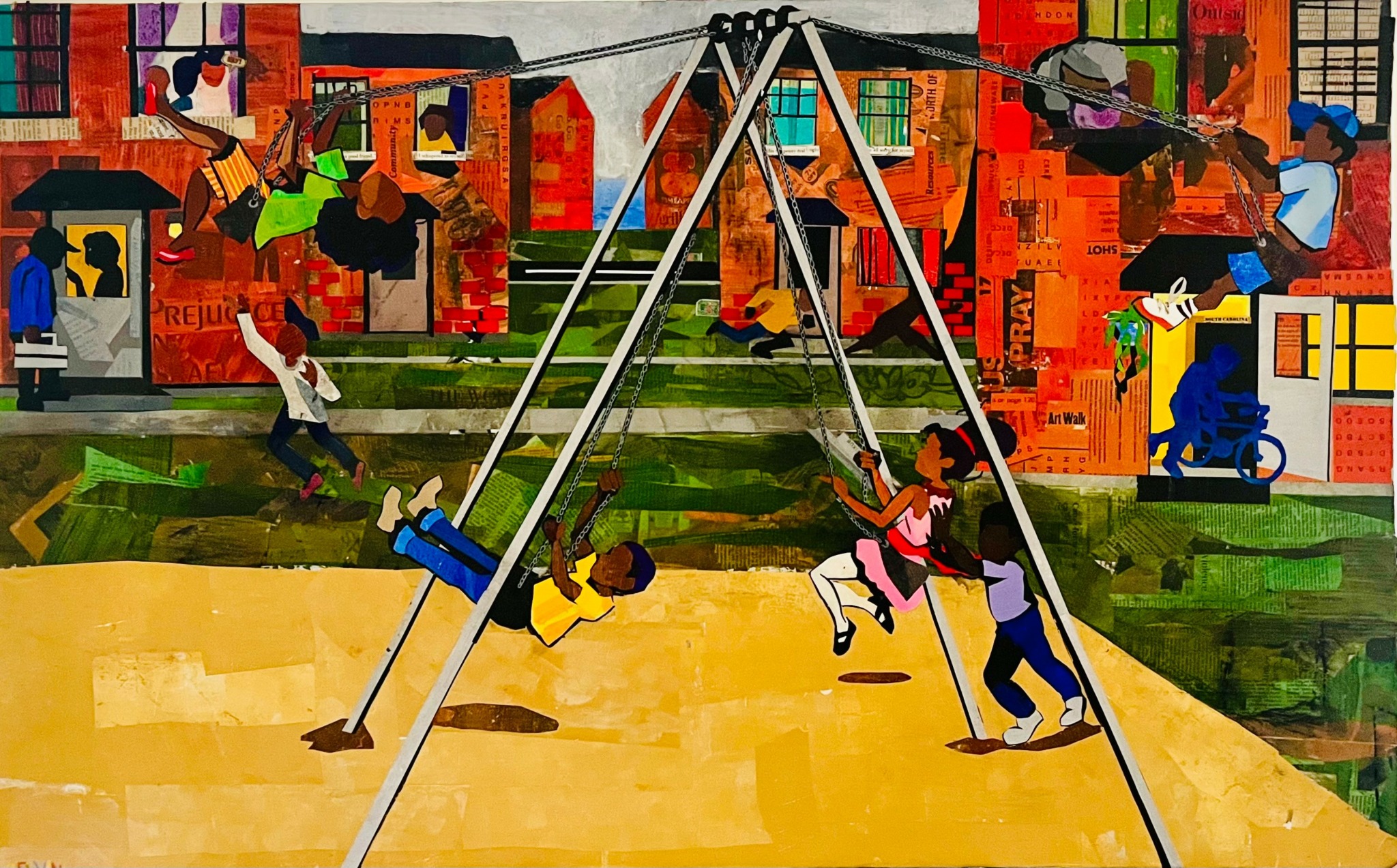We were lucky to catch up with Melvin Nesbitt Jr. recently and have shared our conversation below.
Melvin , looking forward to hearing all of your stories today. We’d love to hear about when you first realized that you wanted to pursue a creative path professionally.
For years, I’d been taking painting classes and painting, with very little success. In an attempt to improve my paintings, I began making small collages of them first, to work out color and compositional issues, before painting on the canvas. I enjoyed the process and results of my collages more than painting. When I was invited to participate in a group show at DC Arts Center, my sister-in-law (and close friend) had just passed away. I was grief stricken and could not focus on painting so I decided to try to make a big collage instead. The process of collaging felt right for this moment in my life because I was hurting, feeling broken and fragmented.
I cut all of the pieces really small then meticulously placed them until I’d finished this meditative process or way of working. It was the first collage piece I’d shared publicly and, to my surprise, it sold on opening night! This gave me a huge confidence boost and I realized I had found my “Lane.”


Melvin , before we move on to more of these sorts of questions, can you take some time to bring our readers up to speed on you and what you do?
My Art is about childhood and community. Specifically, the imagery focuses on a public housing neighborhood where I lived as a kid, Tobias Hartwell Courts that was in Spartanburg, S.C. I was very young when I lived there in the late 1970’s-early 80’s and remember there being a lot of children so I had this endless supply of playmates. When I began making these personal, memory-based imagery, my intention was to focus on a trauma I’d experienced but, after months of emotional and therapeutic studio sessions, I decided to shift the focus of my work to Joy, the innate joy of childhood! I chose this path for 2 reasons: 1) Most of my memories of the old neighborhood were of my friends and playing and I have so many stories from that time that I could probably make art on the subject for the rest of my life.. 2) I didn’t have anything new to add to the vast amount of existing imagery that explores Black trauma.
The medium I’ve chosen is collage and I love the description “painting with paper”! I use painted paper to recreate scenes from my childhood. All of my images (except for some commissions where I used clients’ photos) are invented and from memory.
Without a formal Arts education, I had to take a non-traditional path. I taught myself to draw and had been doing it since I was a kid but in my 30’s I decided to move from South Carolina to Washington D.C. and began taking painting classes at Washington Studio School. There were several professional artists on the faculty and I would volunteer to help them in their studios. I learned a lot from them, especially Susan Yanero, who’s paintings also focus on childhood memories! Through my connections with professional artists I’d hear about opportunities, calls for artists, group shows, available studio spaces, meetings and parties. I used to apply to and attend everything which grew my professional circle. I was putting myself and my Art out there. Trying not to feel insecure that all the other artists were more experienced and educated than me. I fought those insecure feelings by working on my Art a LOT because, the only time I didn’t feel insecure about my work was when I was working. What’s funny is, even with the successes I’ve had, that anxiety still comes to me and I’ve had to learn how to recognize and use it to my benefit. Long story short, I was able to create a career because of Location, Relationships, and my willingness to Do things before I believed I was ready.
The Art I make triggers happy memories in the viewer! My imagery is nostalgic for Black adults and others who lived in the projects as kids. My intention is to remind them of a more innocent time, before you were aware of poverty or racism. After a long day of navigating an unfair system, collectors come home to a piece of Art that makes them smile, something that was made for them, something that’s About them.
I am most proud of representing my old community! You see, the people in “Tob Hartwell” titled me “Artist” long before I accepted the job. Every kid was known and celebrated for their gifts and talents. There were the smart kids, the athletic kids, the kids who danced well, etc. I was one of the kids who could draw! Other kids would ask me to draw their portraits or help them make posters for a school assignment. Adults would say, “He’s the Artist!” My entire adult life I’ve sought community that is as affirming as the community I had a child. I love what they did for me and I want the world to know how many loving and supportive people live in the projects! The success stories we hear about an individual who manage to climb the ladder from poverty to wealth, often happen as a result of the support from their community.


What do you think is the goal or mission that drives your creative journey?
Yes. So, for 4 consecutive years now, I have returned to my old elementary school to do collage workshops with the students (nearly 500 kids in 5 days. Thank God for volunteers! ). This is a rewarding experience because I get to be one of the adults I wanted to meet as a kid! The principal and Art teacher makes a big deal out it every year so, the kids are excited and many of them think I’m famous. (LOL) I never wanted that for myself. I just wanted to live a debt free life working at something I love but, for the kids, I want them to have a successful artist, from their neighborhood, that is accessible to them. I’m going to go as far as I can and keep working at getting better and, hopefully, inspire a bunch of kids to do the same!


What can society do to ensure an environment that’s helpful to artists and creatives?
I tell my students “Creativity is Problem-Solving”. I do this for the ones who think Art-making is just about having fun or expressing yourself, both valid reasons to make Art but, understand that you are problem-solving your way through the process. Instinctively “thinking outside the box” (while working inside of a picture plane but…you get what I’m saying..LOL). With society changing so quickly, we all need to exercise our creative problem-solving skills to survive. So, I encourage society to embrace that aspect of Art-making as exercising critical thinking and problem-solving skills, participate in it more even if you never share your art with anyone, take local classes and encourage creativity in children.
And if society wants to support This artist, they can attend my solo show coming in September at Hemphill Artworks in D.C.!
Thank you!
Contact Info:
- Facebook: Melvin L. Nesbitt Jr.


Image Credits
Headshot by Rodney Choice Photography
Art photographs by Gregory Staley


